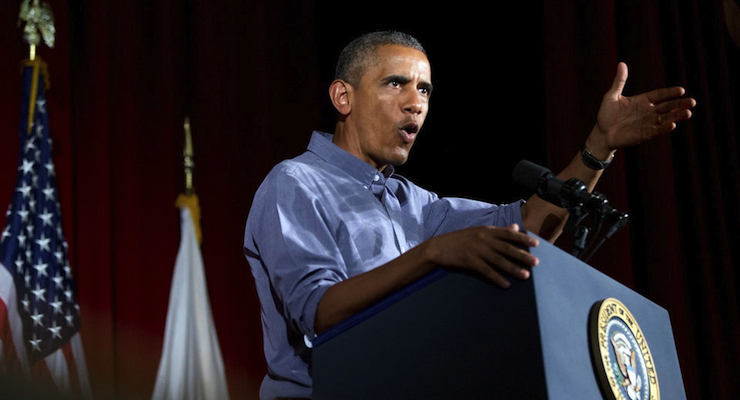

President Barack Obama speaks at the Greater Boston Labor Council Labor Day Breakfast, Monday, Sept. 7, 2015, in Boson. Obama will sign an Executive Order requiring federal contractors to offer their employees up to seven days of paid sick leave per year. (AP Photo/Andrew Harnik)
BOSTON, MASS. — In a move aimed at appeasing labor unions opposed to the Transpacific Trade Partnership, President Obama on Labor Day signed an executive order forcing federal contractors to give paid sick leave to their employees. He denounced Republicans for a “constant attack on working Americans” during a speech at the Greater Boston Labor Council Labor Day Breakfast, saying the GOP “won’t let facts or evidence get in their way.”
“You just wait, you look up at the sky and prosperity will come raining down on us from the top of whatever high-rise in New York City. But that’s not how the economy works,” Obama said, adding that Republican economics have been “wrecking the economy for a long, long time.”
Speaking of facts, how the economy works or what is wrecking it, though the White House claims that there are some 300,000 “workers” under targeted government contractors, they have no idea how many are actually impacted by the executive order. They said roughly 44 million American private sector workers don’t get paid sick leave, but couldn’t estimate how many federal contractors currently don’t offer paid leave.
Further, administration officials discounted the potential impact the order may have on wages, which have decreased by an average $1,500 under Obama’s administration.
The Labor Day decree comes as Obama hopes to smooth over tensions with labor over his trade agenda, as major unions not only oppose his new trade agreement with Asia and Europe but also have threatened to work against Democrats who voted to support TPP in Congress. Unions worry that the secret trade deals will result in job destruction, though the president has signed a law providing money to retrain workers if and when their jobs get outsourced to cheaper overseas markets.
Under the new executive order, employees working on federal contracts gain the right to a minimum of one hour of paid leave for every 30 hours they work, which amounts to 7 days over a 12 month period. Further, the order will allow employees to use the leave to care for sick relatives, as well, and will impact contracts that start in 2017—after Obama leaves office.
Nevertheless, the White House also wouldn’t speculate on the cost to federal contractors to implement the executive order, which critics say will likely come right out of worker’ wages. The Labor Department theorizes that costs would be offset by imaginary savings contractors would realize as a result of lower attrition rates and increased worker loyalty. Of course, they produced nothing by way of evidence, largely because there is no comparable example.
Obama did reference Wisconsin Gov. Scott Walker in his speech, though not by name, when he mocked him for allegedly thinking “union busting” prepared him to take on the Islamic State. However, he made no mention or offered no explanation to the very real union problem of declining membership. The Bureau of Labor Statistics said that union membership in 2015 fell to a 100-year low in the year 2014. In 1983, there were 17.7 million union workers in the labor force (20.1%), but there were just 14.6 million union members in the work force in 2014. That puts the union membership rate at just 11.1%, down another 0.2% from 2013 and 9% since 1983.
AFL-CIO President Richard Trumka managed to bash President Obama for touting the creation of “poverty-level jobs” in his last State of the Union speech, while simultaneously blaming “right-wing billionaires’ extremist politics, a rapacious Wall Street and insufficient advocacy from political leaders” that has led to low-wage job creation. To be fair, the jobs Trumka highlighted have accounted for roughly 70% of the jobs created under the Obama administration, which the CBO blamed largely on ObamaCare.
Yet, he failed to recognize the hit organized labor has taken among American public opinion. At the heart of unions’ declining membership problems is a long-observed ideological shift in America and distrust that is fueling increased disapproval in organized labor. Unions have taken a significant hit in the courts, as well. In June 2014, the Supreme Court ruling in Harris v. Quinn dealt a significant blow to the effort to expand public employee unions, though it did not gut them.
Massachusetts’ voters in the state approved a similar paid leave policy state-wide, which took effect July 1. It is expected to affect 900,000 workers who previously received no paid leave, the White House said, though again, offered little concrete data to back it up.
The most damning journalistic sin committed by the media during the era of Russia collusion…
The first ecological study finds mask mandates were not effective at slowing the spread of…
On "What Are the Odds?" Monday, Robert Barnes and Rich Baris note how big tech…
On "What Are the Odds?" Monday, Robert Barnes and Rich Baris discuss why America First…
Personal income fell $1,516.6 billion (7.1%) in February, roughly the consensus forecast, while consumer spending…
Research finds those previously infected by or vaccinated against SARS-CoV-2 are not at risk of…
This website uses cookies.